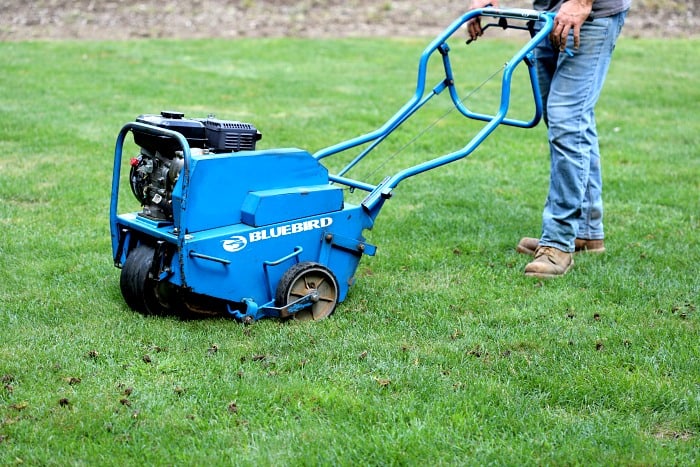Core aeration and overseeding is one of the best ways to repair your lawn if it’s showing sings of weakness. Even if your lawn doesn’t require overseeding, it’s beneficial to add core aeration to your lawn care program.
What is Core Aeration
Aeration is simply the introduction of air into a material. In core aeration, you are introducing air into the soil of your lawn, using a machine called a core aerator. The core aerator works by having several hollow metal tines simultaneously dig into your lawn, removing sections of soil. These sections of soil are called plugs and they remain on the surface of your lawn until they naturally get broken down.
Benefits of Core Aeration
1. Breaks down thatch. A layer of thatch can suffocate your lawn.
2. Reduces soil compaction which allows roots to grow deeper.
3. Provides air to the root system of your lawn which makes healthier roots.
4. Allows fertilizer and water to access root zone easier.
5. When combined with overseeding it makes for optimal conditions to grow seed.
The seed can get into the voids left behind from the aerator and this makes for good seed to soil contact.
If you were to just overseed your lawn without core aerating, most of the seed would stay on the surface of your lawn. It has a greater chance of drying out and dyeing before it has a chance to germinate.
When Is Best Time to Core Aerate and Overseed Your Lawn?
For cool season grasses:
If overseeding, then late summer/early fall is the best time. At this point in the season a lot of annual weeds such as crabgrass are starting to die back and soil temps are ideal for seed germination.
If you wait until mid fall, there’s a good chance a lot of seed won’t germinate due to cooler soil temps.
Cool season grasses germinate best when soil temps are between 50 and 60 degrees Fahrenheit. But you want to get your seed down before that because soil temps drop quickly in the fall, and seed can take awhile to germinate. When soil temps drop down to 70 degrees towards the end of summer, it’s a good time to pull the trigger on core aeration and overseeding.
To get data of when soil temps in your region are in the 70 degree range check out Green Cast Online.
When using Green Cast for soil temp data, enter your zip code and look at the 24 hour average. If 24 hour average temps are 70 degrees or lower, it’s a good indication it’s time to core aerate and overseed. The other factor worth considering is the 5 day forecast. If you’re getting unexpected extreme heat, then wait until temps cool back down.
If just core aerating your lawn then you don’t have to worry about seed germination so you can do that later in the season.
For warm season grasses:
Late Spring/ Early Summer is the best time to aerate since this is when warm season grasses are actively growing.
Since warm season grasses spread via rhizomes and or stolons, there really isn’t a need to overseed after aeration. Their spreading nature fills in the voids left behind from core aeration. However, if you are doing more of a lawn renovation then you can seed right after core aerating.
Another overseeding strategy people use with warm season grasses is to overseed with an annual rye grass in the fall when warm season grass starts to enter dormancy. This will give you green grass during the winter months while warm season grasses are dormant.
This is a strategy you commonly see in golf courses down south. The annual rye thrives in the winter months and dies back with the return of the heat and warm season grasses coming out of winter dormancy.
If overseeding with annual rye, wait until fall when soil temps are cooling down and warm season grasses are starting to head into dormancy.
How to Core Aerate and Overseed Your Lawn
1. Mow Your Lawn
Before core aerating and overseeding make sure you mow your lawn short. This will allow the core aerator to dig into the soil better and pull out deeper cores.
2. Water
When core aerating, you want your lawns soil to be moist so the core aerator can easily penetrate the soil and remove a solid core.
3. Aerate
Aerate your lawn twice if possible, going in perpendicular directions. Set your core aerator to the deepest setting. Don’t be afraid to get a quick lesson at the rental yard if you are renting a machine.
4. Apply Seed
If applying seed, immediately after core aeration is the time to do it. Follow the overseeding rates on the back of the bag of fertilizer. You don’t want to overseed too heavily!
5. Apply Slow Release Fertilizer
Applying fertilizer is ok immediately after overseeding but you want it to be a slow release fertilizer such as Milorganite 6-4-0. If you use a quick release fertilizer the surrounding grass will have a growth spurt and it will shade out the seed and require you to mow more often.
6. Irrigate
Irrigate immediately after core aeration and overseeding if possible. Otherwise, do your best to schedule aeration and overseeding right before a light rain is forecasted.
7. Mow
Mow your lawn as needed over the next weeks as your seed germinates but be careful. Only go over the lawn once and try to avoid turning sharply. You want to do what you can to be gentle as your new seed germinates. Your seed needs sunlight to germinate so don’t make the mistake a lot of people make and stop mowing while you wait for seeds to germinate.
Check Out These Posts Next
Top Dressing Lawn: Benefits and Advice
Lawn Dethatching: Everything You Need to Know
Lawn Care Program Using Only 3 Products
How to Kill Weeds Without Killing Grass
White Grubs: Prevention and Treatment
Follow Me
Join my free email list!
Plus, follow me on Facebook, Instagram, and Pinterest.



Excellent information that I really can use and I will put it to practice ASAP.
Thank you for your help in teaching me how to maintain my yard. I am in the cool seed zone and would like to seed my lawn this spring. I tried seeding this last fall but it was too late. I haven’t used any weed killer so I believe I shouldn’t have any trouble. Also your article mentioned that the cool grass seed germinates the best with ground temperatures 50-60 degrees. Am I correct in my plan? Thank you for your help. Bill
You’re very welcome Bill, happy to hear I was able to help. You are correct with the soil temperatures, I would should for and average 5 day soil temp of 55 degrees to pull the trigger on your spring lawn renovation. You might have some weeds that germinate along with your grass but that’s just the nature of the beast with spring seeding. In the fall a lot of those weeds will die back and you’re lawn should take over.
Very good article explaining and improving the chances of success…..One extra point that I have found successful is to spread the grass seed BEFORE hollow tine coring as it allows more seed coverage increasing the seed/soil contact …..I then use the back of a rake to break up and level out the plugs….Rolling the area afterwards also seems to help with keeping the seed moist…
Thanks Paul! I agree, if you can get your hands on a roller afterwards it definitely helps with seed to soil contact. The back of a rake works well too. I actually do that method whenever I have a lawn repair job just to get the seed into the soil a bit more.
I actually have a question. It says if you’re overseeding then you should add starter fertilizer. Once that grass takes, should you still add your fall fertilizer before the season is completely over? Or just leave it at overseeding and starter fertilizer?
Hi Mike! Once the grass gets established I would actually hit it with another round of starter fertilizer. The younger grass will benefit from the increased phosphorus (the middle number on the fertilizer label). Hitting it with the fall fertilizer isn’t necessarily bad or wrong, but personally I like to hit new grass with another round of starter fert.
Much appreciated. I’ll give it a shot. Thank you.
I have a badly damaged garden(dog urine) will aerating& reseeding help regards eamon e
Hi Eamon, yes core aerating and overseeding will help if you need to repair your lawn. However, if it’s just some spots you could always just rake the area good to scratch the surface of the soil and add some quality loam over the area and seed. This would save you from having to rent and aerator if it’s not a large area.
Hi Mark, this is Chris from Greensboro North Carolina. I aerated my yard put out grass seed three weeks ago. I had a lot of dead grass so I had to rake it before I put grass it out but it’s still not coming up yet. Do I need to do anything else the heat got to my fescue And I had a wreck the dead grass out and is it too late to fix it and put out more grass seed?